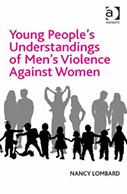Young People’s Understandings of Men’s Violence Against Women

Author: Nancy Lombard
Publisher: Farnham, Surrey ; Burlington, VT : Ashgate, 2015. 228p.
Reviewer: Amber L. Morczek | March 2016
Young People’s Understandings of Men’s Violence Against Women is an exhaustively researched examination of how young people conceptualize and process violence. More specifically, author Nancy Lombard looks at how 11 and 12 year olds perceive gender, violence, and gendered violence, via the use of innovative and rigorous qualitative methodology that is rarely employed with young people without significant empirical challenges and ethical dilemmas. Through her research, Lombard is able to use feminist and childhood theories to highlight how young people perceive the interplay of gender and violence, and how they craft quite complex justifications for that violence and indications of its’ normalcy.
One of the key arguments in the book is that understanding how young people construct violence is part of understanding how they construct gender, beginning from a very early age and sometimes (often) without direct experience. Lombard cites specific examples of how young people conceptualize such topics by highlighting some of the dialogue she had with her subjects. This inclusion of actual discourse from young people gives the reader insight into exactly how young girls and boys think, process, and articulate gendered violence. These specific examples from young people are complementary to Lombard’s more academic discussion and theoretical framing of her research. Although the detailed nuance scrupulously described in the book simply cannot be appropriately summarized in this review, I assure potential readers that Young People’s Understandings of Men’s Violence Against Women greatly contributes to interdisciplinary scholarship and will be useful for feminist scholars in particular.
The intended audience for the book would almost certainly be social scientists. But others would benefit from reading the text as well. Lombard is able to highlight how children are not immune to the cultural messaging normalizing violence toward women, and by doing so, she provides insight into just how pervasive the cultural mores that normalize violence toward women are.
It is clear that author Nancy Lombard’s goal of confronting and challenging the insidious and pervasive social problem of men’s violence toward women is achieved via her multifaceted and scholarly research. She successfully counters the perception that young people are somehow incapable of having articulate discussions about this challenging topic. In sum, I highly recommend Young People’s Understandings of Men’s Violence Against Women to other scholars who are seeking a timely and meaningful text about how young people conceptualize gender, violence, and gendered violence.
Amber L. Morczek, PhD Candidate, Washington State University, Department of Criminal Justice and Criminology


